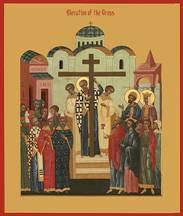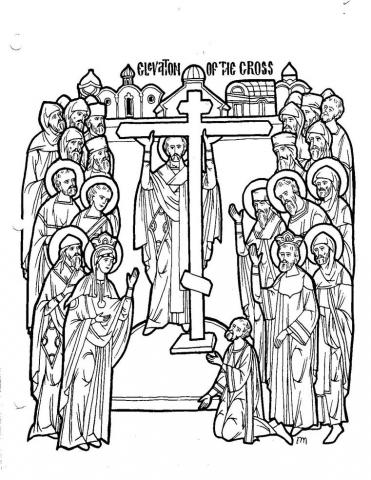Elevation of the Cross
THE ELEVATION OF THE CROSS
 Objectives:
Objectives:
- Children should recognize a cross and how to make the sign of the cross.
- Children should know the story of St. Helen and the finding of the Holy Cross.
- Why is the cross important to us as Christians? Christ died on the cross.
The cross shows us how much Jesus loves us.
Possible lesson plan:
- Open with prayer. Practice making the sign of the cross as you pray.
- Tell the story of St. Helen and the finding of the Holy Cross, using the icon as a picture to illustrate the story for the students:
The Empress Helen, mother of the great Emperor Constantine, was traveling to the Holy Land, the land where Jesus had lived and died and risen from the dead. All the palace was in an uproar. The servants prepared food for the journey, packed the clothing, and made everything ready for the royal family to travel. The Empress was a Christian – one who believed that Jesus was the true God. She was going to the Holy Land to find the places and things the Bible told about.
Soon, the royal party – the empress, her ladies, her soldiers, and her servants – reached the Holy Land. The royal ship, with its sails of purple silk trimmed with gold, landed at the port of Joppa on the Mediterranean Sea. There, camels and horses and donkeys waited to carry them inland. The road was hot and dusty; the sun beat down on them. Finally, they reached the city of Jerusalem. They could almost feel the presence of Jesus. These were the very streets He had walked about 300 years before.
Empress Helen had the servants put up silken tents on a hill outside the city. The hill was called Golgotha, a dusty mound with a few bent and twisted old olive trees growing nearby. What was special about this hill? The Bible says that Golgotha was where Jesus was crucified. No one had seen the cross on which the Lord died, but, somewhere on that dusty hill, Empress Helen was sure that she would find three crosses. The Lord had given her many dreams and visions that had started her on this journey. He would surely show her how to complete her task. Helen Prayed. Then, she told her men to begin digging, not on top of the hill, but in a little gully to the side. As they dug, the men became more and more excited. Suddenly, one of them found something wooden. It was a cross! Soon, there were three wooden crosses uncovered. But, which one was the cross of Jesus Himself?
The Bishop of Jerusalem, Macarius, suggested a way to find out. He know of a woman who was sick, so sick she was about to die. He had his servants carry the woman out to the hill. The woman was tired and wondered what was happening. Then, the bishop asked the sick woman to touch the first cross; nothing happened. She touched the second cross; nothing happened. Then she touched the third cross; suddenly she was full of energy and life and was well again. Surely this was the true cross of Christ!
The Empress Helen sent word to her son, the Emperor Constantine, that they had found the true cross of Jesus Christ. There was rejoicing in all the Christian Churches. The emperor ordered that a church be built there on the Mount of Olives. He reminded all the people that, wonderful though it was to find the wooden cross on which Jesus was crucified, we do not worship the cross but the Lord who died on it. And so it is to this day.
- True or false (As we discussed in the first part of the book, use these on a paper peanut to play “Feed the Elephant” for the smaller children:
True False
Helen was the mother of Constantine. Constantine found the cross of Jesus.
Helen traveled to Jerusalem. Helen found the cross in Constantinople.
The cross was on a hill called Golgotha. The cross was in the Garden of Gethsemane.
A church was built where the cross was The bishop threw dice to choose the true
found. Cross.
Constantine was the Emperor of Rome. The Bishop of Jerusalem was Constantine.
- Talk about how a cross can look. Show examples of different styles of cross. Think about places where we see a cross, or take a “field trip” to the sanctuary to “hunt” for crosses.
- Teach and sing, complete with prostrations:
Before thy cross, we bow down in worship, O Master,
And thy holy resurrection we glorify.
6. Why “basil” at the Feast of the Cross? The herb, basil has long been associated with the feast of the Exaltation of the Holy Cross. The word “basil” is derived from “Vasileios,” the Greek word for a king or person of royal lineage.
According to the liturgical tradition, the Holy Empress Helena, Mother of the Saint and King Constantine, found the location of the True Cross by digging for it under a large growth of basil. Basil plants were reputed to have sprung up at the foot of the Cross where the Precious Blood of Christ fell, along with the tears of the Mother of God. On the Feast of the Exaltation of the Holy Cross it is customary in the East to rest the image of the Holy Cross on a bed of basil before carrying it out for the veneration of the faithful. Also, in some areas, branches of basil are used throughout the temple as a festive decoration as well as to provide a heavenly scent in honor of the Feast. Blessed basil leaves may also be arranged in a bouquet at the foot of the “Golgotha” cross. Dried leaves taken from the feast can also be used by the faithful as a sweet incense to burn at home as a blessing.
Why not plant some basil today in an egg carton to take home and water? Plant it next spring in the yard and have a lovely plant for next year’s feast.
7. Cross Craft – stained glass cross: Ahead of time, cut out a construction paper cross for each student and shave several crayons into curls. Give each student a piece of wax paper about 18 inches long. Place the cross in the center and have the children surround it with shavings of crayon. Place another piece of wax paper over the first and iron lightly, melting the crayons and the wax paper together as “stained glass”. Hang in a window.
8. Conclude with prayer, again practicing the sign of the cross.
